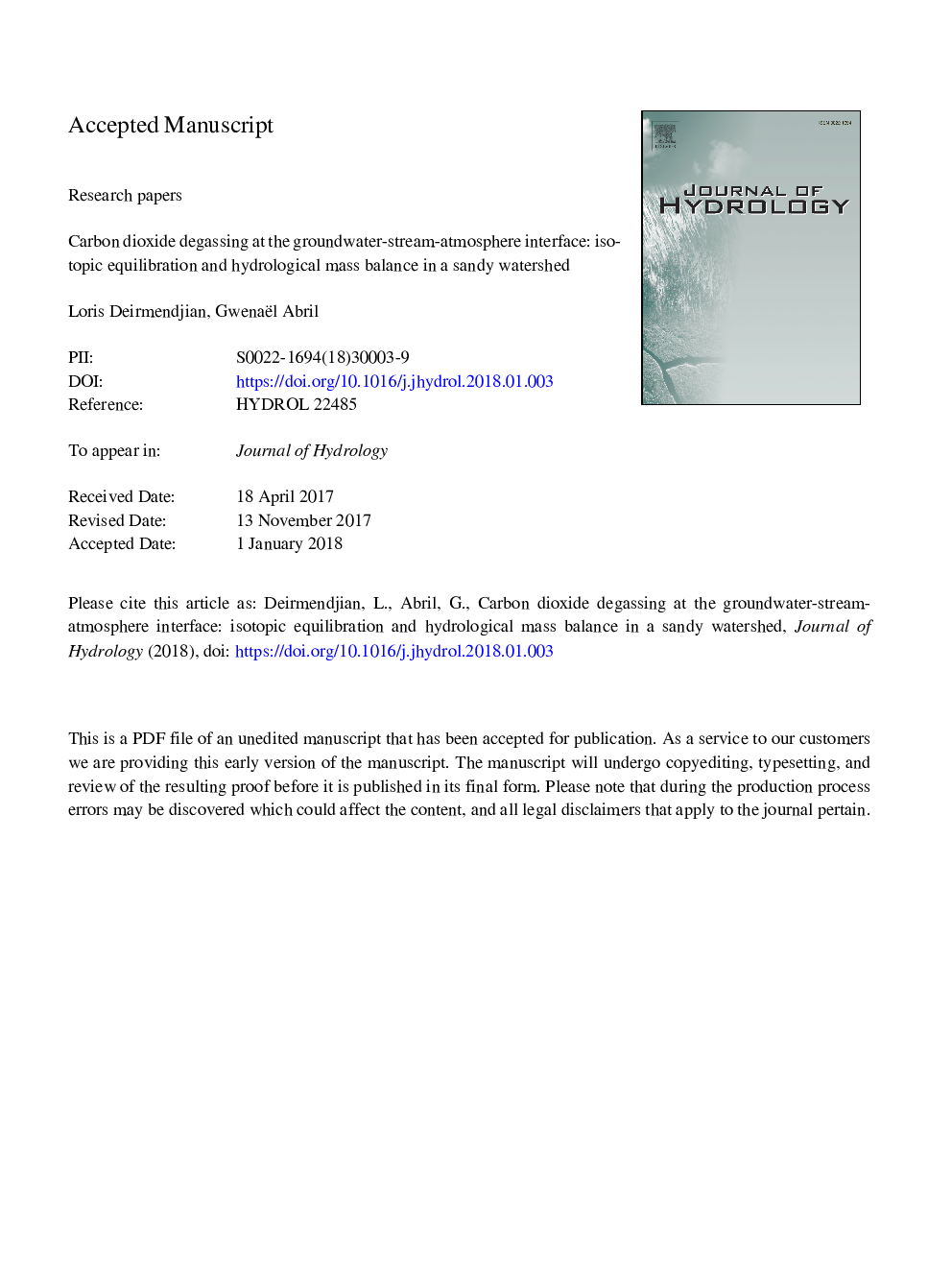| کد مقاله | کد نشریه | سال انتشار | مقاله انگلیسی | نسخه تمام متن |
|---|---|---|---|---|
| 8894975 | 1629896 | 2018 | 53 صفحه PDF | دانلود رایگان |
عنوان انگلیسی مقاله ISI
Carbon dioxide degassing at the groundwater-stream-atmosphere interface: isotopic equilibration and hydrological mass balance in a sandy watershed
ترجمه فارسی عنوان
دگرگونی دی اکسید کربن در رابطۀ آب زیرزمینی-جریان-جو: تعادل ایزوتوپ و تعادل جرمی هیدرولوژیکی در حوضه
دانلود مقاله + سفارش ترجمه
دانلود مقاله ISI انگلیسی
رایگان برای ایرانیان
کلمات کلیدی
موضوعات مرتبط
مهندسی و علوم پایه
علوم زمین و سیارات
فرآیندهای سطح زمین
چکیده انگلیسی
Streams and rivers emit significant amounts of CO2 and constitute a preferential pathway of carbon transport from terrestrial ecosystems to the atmosphere. However, the estimation of CO2 degassing based on the water-air CO2 gradient, gas transfer velocity and stream surface area is subject to large uncertainties. Furthermore, the stable isotope signature of dissolved inorganic carbon (δ13C-DIC) in streams is strongly impacted by gas exchange, which makes it a useful tracer of CO2 degassing under specific conditions. For this study, we characterized the annual transfers of dissolved inorganic carbon (DIC) along the groundwater-stream-river continuum based on DIC concentrations, stable isotope composition and measurements of stream discharges. We selected a homogeneous, forested and sandy lowland watershed as a study site, where the hydrology occurs almost exclusively through drainage of shallow groundwater (no surface runoff). We observed the first general spatial pattern of decreases in pCO2 and DIC and an increase in δ13C-DIC from groundwater to stream orders 1 and 2, which was due to the experimentally verified faster degassing of groundwater 12C-DIC compared to 13C-DIC. This downstream enrichment in 13C-DIC could be modelled by simply considering the isotopic equilibration of groundwater-derived DIC with the atmosphere during CO2 degassing. A second spatial pattern occurred between stream orders 2 and 4, consisting of an increase in the proportion of carbonate alkalinity to the DIC accompanied by the enrichment of 13C in the stream DIC, which was due to the occurrence of carbonate rock weathering downstream. We could separate the contribution of these two processes (gas exchange and carbonate weathering) in the stable isotope budget of the river network. Thereafter, we built a hydrological mass balance based on drainages and the relative contribution of groundwater in streams of increasing order. After combining with the dissolved CO2 concentrations, we quantified CO2 degassing for each stream order for the whole watershed. Approximately 75% of the total CO2 degassing from the watershed occurred in first- and second-order streams. Furthermore, from stream order 2-4, our CO2 degassing fluxes compared well with those based on stream hydraulic geometry, water pCO2, gas transfer velocity, and stream surface area. In first-order streams, however, our approach showed CO2 fluxes that were twice as large, suggesting that a fraction of degassing occurred as hotspots in the vicinity of groundwater resurgence and was missed by conventional stream sampling.
ناشر
Database: Elsevier - ScienceDirect (ساینس دایرکت)
Journal: Journal of Hydrology - Volume 558, March 2018, Pages 129-143
Journal: Journal of Hydrology - Volume 558, March 2018, Pages 129-143
نویسندگان
Loris Deirmendjian, Gwenaël Abril,
